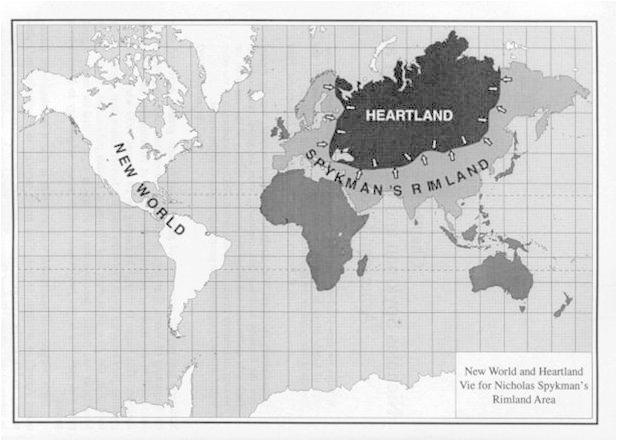The end of World War II saw the emergence of two major superpowers, the USSR and the United States, which held absolutely differing ideologies. While the USSR viewed capitalism as sybaritic and embraced communism as a tool for human equality, U.S believed in egalitarianism. The two irreconcilable ideologies of communism and liberal capitalism resulted in heightened tension between the two. However, cognisant that direct confrontation would only lead to disastrous repercussions, both sought not to engage in direct warfare, but instead chose to engage in proxy wars. Interestingly, the actions of both parties in perpetuating these wars align with geopolitical theories, like Mackinder’s Heartland Theory, Spykman’s Rimland Theory and Ratzel’s organic state theory.
Ratzel’s state theory states that states are analogous to living organisms and just as living organisms require nutrition to grow, states require land to grow.[1] This means that territorial expansion was imperative for state survival. In the Cold War context, the existence of 2 mutually exclusive ideologies was not to be tolerated and required the annihilation of one and domination of the other. Yet, since both were roughly equal in military might, any direct confrontation would only risk nuclear fallout, which benefited neither party.[2] Hence, both could only seek to exert their political might through conquering other lands and engaging in warfare in other lands (proxies), such as Vietnam, Korea and Africa.
Throughout the Cold War, however, U.S consistently emphasized that they were not acting in their own interests, but sought to contain USSR’s increasing dominance. By the end of WW2, the Soviet Union had already gained control of most of the “Heartland” and this proved to be a threat to world order, as Mackinder had proclaimed that
“Who rules East Europe commands the Heartland, Who rules the Heartland commands the World-Island, Who rules the World-Island commands the world.”[3]
At the same time, USSR was also gaining control of territories in the rimland. This was also a threat as Spykman prophesised that:
“Who controls the rimland rules Eurasia; who rules Eurasia controls the destinies of the world.”[4]

Figure 1. Mackinder’s Heartland Theory and Spykman’s Rimland Theory[5]
Fearing that communism would spread like wildfire and threaten the ideals of liberty, US felt it necessary to intervene and halt USSR’s growing dominance through proxy wars. One notable example was the Vietnam War, in which Americans believed that the fall of Vietnam to communism would create a domino effect throughout Southeast Asia and lead to a complete communist takeover.[6]
However, this fear was unfounded. Even as Vietnam fell to communist forces, most nations in the region remained out of communist control. And in fact, Mackinder’s theory did not materialize. In spite of its heartland advantage, USSR failed to achieve world dominance due to inefficient economic administration. Meanwhile, Spykman’s theory is contestable as neither power managed to gain control of the rimlands, so by right, none should have emerged as a superpower. But the US emerged as the sole superpower.
Nonetheless, it is riveting to explore these through geopolitical lens, rather than the traditional historical perspective.
[1] Dittmer, J., & Sharp, J. (2014) Geopolitics: An introductory reader.
[2] Gary E. Oldenburger. (n.d.). The Cold War: The Geography of Containment. Retrieved March 11, 2016, from http://www.oldenburger.us/gary/docs/TheColdWar.htm
[3] Ibid
[4] Ibid
[5] [Spkyman Rimland Theory and Mackinder Heartland Theory]. (n.d.). Retrieved March 11, 2016, from https://classconnection.s3.amazonaws.com/103/flashcards/1000103/jpg/rimland-142E9B026D12BB3144B.jpg
[6] History.com Staff. (2009). Domino Theory. Retrieved March 12, 2016, from http://www.history.com/topics/cold-war/domino-theory